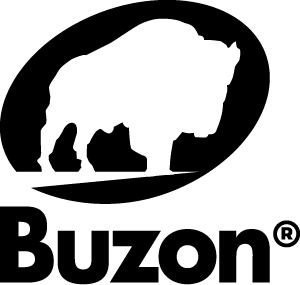Pedestal Paver FAQs: Ask Buzon
Pedestal pavers are a versatile solution for creating level decks, rooftop terraces, and raised flooring. Below you’ll find answers to the most common questions about pedestal pavers, including installation, substrates, slopes, drainage, noise control, and stability.
This page is your go-to resource for practical insights. Each month in our ASK Buzon feature from the Buzon newsletter, we respond to real-world questions from architects, landscape architects, builders, installers, and developers. Browse the archive below or jump directly to a topic:
Stay Updated
Want the latest FAQs and pro tips delivered directly to your inbox?
View past newsletters.
Pedestal Paver FAQs: Installation & Substrates
These pedestal paver FAQs cover the basics of installation, substrates, and site conditions. Learn how Buzon pedestals perform over different surfaces, when to use low-profile options, and how to stabilize bases in challenging environments.
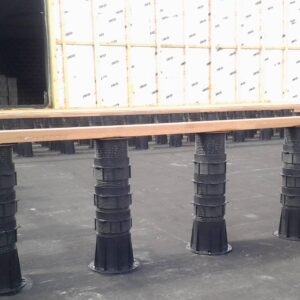 Buzon BC- and PB-Series pedestals can be installed on any type of substrate, such as roofing membranes (including EPDM), insulation boards, cement screed, etc. The large pedestal base enables installation directly over roofing membranes and insulation panels.
Buzon BC- and PB-Series pedestals can be installed on any type of substrate, such as roofing membranes (including EPDM), insulation boards, cement screed, etc. The large pedestal base enables installation directly over roofing membranes and insulation panels.
Related Resource: Learn how rubber pads under pedestals can protect membranes, improve stability, and reduce noise. Read the guide.
- Read this ASK Buzon in the original newsletter issue.
 Buzon pedestals are waterproof, do not absorb water, and are fully submersible. Water flows freely through holes in the pedestal head and base. It is no surprise that Buzon pedestals are the gold standard for water features in 50 countries. For raised deck applications, the eight holes in the pedestal base keep water flowing through the pedestal towards the drains.
Buzon pedestals are waterproof, do not absorb water, and are fully submersible. Water flows freely through holes in the pedestal head and base. It is no surprise that Buzon pedestals are the gold standard for water features in 50 countries. For raised deck applications, the eight holes in the pedestal base keep water flowing through the pedestal towards the drains.
- See water features on the Buzon pedestals projects page.
- Read this ASK Buzon in the original newsletter issue.
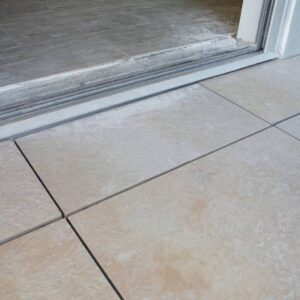 To establish your finished floor elevation (FFE), typically begin at the door threshold. Get the height just outside the door threshold if that is your highest point of your substrate. Then move toward the drains.
To establish your finished floor elevation (FFE), typically begin at the door threshold. Get the height just outside the door threshold if that is your highest point of your substrate. Then move toward the drains.
- Learn more in the pro-tip section in this blog post.
- Read this ASK Buzon in the original newsletter issue.
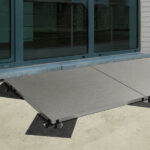 When working with tight clearances around door thresholds, elevated patios, balconies, and rooftop decks, low-profile pedestal solutions can solve a pesky problem. Buzon offers pedestal heights as low as 3-10mm (1/8″ – 3/8″) using U-TABS-FLAT and U-PADS-GROUND (1/8″) in combination with porcelain pavers (3/4″). This allows architects and builders to create a raised pedestal system under 1 inch from substrate to finished floor. As the design extends toward drainage points, taller pedestals can be integrated to maintain a level surface.
When working with tight clearances around door thresholds, elevated patios, balconies, and rooftop decks, low-profile pedestal solutions can solve a pesky problem. Buzon offers pedestal heights as low as 3-10mm (1/8″ – 3/8″) using U-TABS-FLAT and U-PADS-GROUND (1/8″) in combination with porcelain pavers (3/4″). This allows architects and builders to create a raised pedestal system under 1 inch from substrate to finished floor. As the design extends toward drainage points, taller pedestals can be integrated to maintain a level surface.
- See the options in this brochure.
- Read this ASK Buzon in the original newsletter issue.
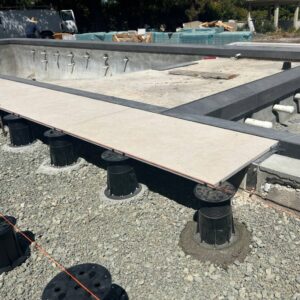 Yes, installers sometimes set pedestal bases in mortar or concrete slurry to stabilize them over gravel or in windy locations. This method helps keep pedestals in place during construction and maintenance, especially near drains or access points. But once fixed, they can’t be adjusted, so placement must be precise. Other options for added stability include ballast gravel, partial burial, or epoxy anchor bolts on concrete substrates.
Yes, installers sometimes set pedestal bases in mortar or concrete slurry to stabilize them over gravel or in windy locations. This method helps keep pedestals in place during construction and maintenance, especially near drains or access points. But once fixed, they can’t be adjusted, so placement must be precise. Other options for added stability include ballast gravel, partial burial, or epoxy anchor bolts on concrete substrates.
- Read this ASK Buzon in the original newsletter issue.
Pedestal Paver FAQs: Slopes & Drainage
Slopes and water management are common design concerns. In these pedestal paver FAQs, we explain slope correctors, drainage solutions, and how to handle non-uniform pavers while maintaining a level, safe walking surface.
 Utilize a top slope corrector independently with BC pedestals or in conjunction with base slope correctors to create a sloped surface or ramp, achieving slopes of up to 15-20%. Keep in mind that an ADA curb ramp must adhere to a 1:12 ratio, equating to an 8.33% slope maximum.
Utilize a top slope corrector independently with BC pedestals or in conjunction with base slope correctors to create a sloped surface or ramp, achieving slopes of up to 15-20%. Keep in mind that an ADA curb ramp must adhere to a 1:12 ratio, equating to an 8.33% slope maximum.
- Read these instructions to learn more about creating ramps and sloped surfaces.
- Read this ASK Buzon in the original newsletter issue.
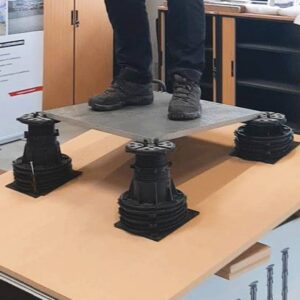 For slopes over 5%, combine BC-PH5 base slope correctors with BC-1 pedestals—each corrector adds 5% more slope correction. The BC-1 pedestal nests inside the correctors, locking together with pins for stability. Add a PH5 top slope corrector to fine-tune the walking surface, enabling ramps or surfaces with slopes up to 15-20%.
For slopes over 5%, combine BC-PH5 base slope correctors with BC-1 pedestals—each corrector adds 5% more slope correction. The BC-1 pedestal nests inside the correctors, locking together with pins for stability. Add a PH5 top slope corrector to fine-tune the walking surface, enabling ramps or surfaces with slopes up to 15-20%.
- Learn more how to master slope with Buzon.
- Read this ASK Buzon in the original newsletter issue.
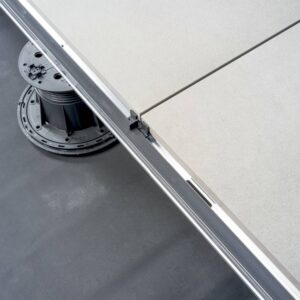 The E-BRS Easy Rail System is designed to keep water moving. Each aluminum joist includes pre-punched drain holes that allow rainwater to pass through and flow freely to the substrate below. This prevents water buildup on or inside the joists. Paired with E-BRS spacer tabs that maintain consistent gaps between pavers, the system ensures precipitation drains efficiently through the surface. The result: a stable, low-maintenance installation that resists water-related damage over time.
The E-BRS Easy Rail System is designed to keep water moving. Each aluminum joist includes pre-punched drain holes that allow rainwater to pass through and flow freely to the substrate below. This prevents water buildup on or inside the joists. Paired with E-BRS spacer tabs that maintain consistent gaps between pavers, the system ensures precipitation drains efficiently through the surface. The result: a stable, low-maintenance installation that resists water-related damage over time.
- Read this ASK Buzon in the original newsletter issue.
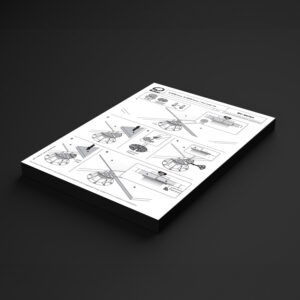 Non-uniform tile thickness is common. Shims are available to adjust small differences in thickness, coming in 1 and 2 mm options. Simply place them directly on top of the pedestals.
Non-uniform tile thickness is common. Shims are available to adjust small differences in thickness, coming in 1 and 2 mm options. Simply place them directly on top of the pedestals.
- Download the install sheet.
- Read this ASK Buzon in the original newsletter issue.
Pedestal Paver FAQs: Noise Control & Stability
Foot traffic, wind, and structural movement can all impact stability. These pedestal paver FAQs explore ways to reduce noise, prevent paver shifting, and reinforce pedestal systems for long-term performance.
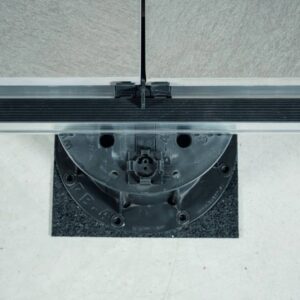 To minimize impact noise from foot traffic—whether walking, running, or jumping—under roof paver pedestals, Buzon offers several solutions:
To minimize impact noise from foot traffic—whether walking, running, or jumping—under roof paver pedestals, Buzon offers several solutions:
- U-PAD (3-10mm) and U-PAD-GROUND (2-10mm): These pads provide a cushioning layer to absorb sound and vibrations.
- U-E10 (1mm) and U-E20 (2mm): Shock-absorbing shims designed to enhance noise reduction and impact resistance when fine-tuning pedestal height.
- E-BRS System: Features factory-installed EPDM shock-absorbing joints for additional sound dampening and vibration control.
- Read this ASK Buzon in the original newsletter issue.
 Using a fastener that screws into the top of the pedestal head and slides into kerf cut grooves in pavers secures pavers and prevents movement in various weather conditions, including windy events. It ensures that the pavers stay in place and helps maintain the overall stability and safety of the raised floor system.
Using a fastener that screws into the top of the pedestal head and slides into kerf cut grooves in pavers secures pavers and prevents movement in various weather conditions, including windy events. It ensures that the pavers stay in place and helps maintain the overall stability and safety of the raised floor system.
- Learn more about kerf cuts and the Buzon PB Fastener.
- Read this ASK Buzon in the original newsletter issue.
Pedestal Paver FAQs: Edging & Finishing
A clean, professional edge is essential for both safety and aesthetics. In this section of pedestal paver FAQs, discover how to finish porcelain terraces and enclose the perimeter of elevated decks.
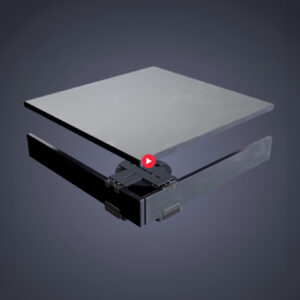 The Buzon PB-Edge Finish Kit is used to create a clean finished edge on a raised porcelain deck installation. It can be used on a side or corner of a pedestal paver deck.
The Buzon PB-Edge Finish Kit is used to create a clean finished edge on a raised porcelain deck installation. It can be used on a side or corner of a pedestal paver deck.
- Watch this video for a demonstration.
- Download the PB End brochure
- Read this ASK Buzon in the original newsletter issue.
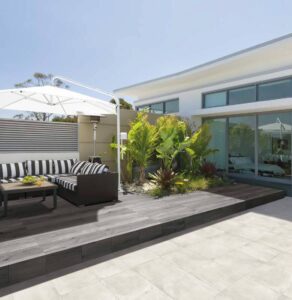 Raised decks installed on pedestals create an open cavity beneath the surface that needs to be concealed for both aesthetic and safety reasons. The Buzon PB-End Finishing Kit is designed specifically for this purpose. It creates a clean, professional-looking edge using the same porcelain pavers as the deck surface.
Raised decks installed on pedestals create an open cavity beneath the surface that needs to be concealed for both aesthetic and safety reasons. The Buzon PB-End Finishing Kit is designed specifically for this purpose. It creates a clean, professional-looking edge using the same porcelain pavers as the deck surface.
PB End Finishing Kit Components
The system consists of three parts—the U-End-Base, U-End-Lock, and PB-End-Top—that work together to form a stable lateral edge or full corner. The result is a finished “skirt” around the terrace that eliminates the need for pony walls or other structural enclosures.
- Read this ASK Buzon in the original newsletter issue.
Pedestal Paver FAQs: Joists & Bracing
For taller installations or when working with aluminum joists, bracing and load distribution matter. These pedestal paver FAQs explain joist spacing, EPDM hardness ratings, and when to add bracing for extra stability.
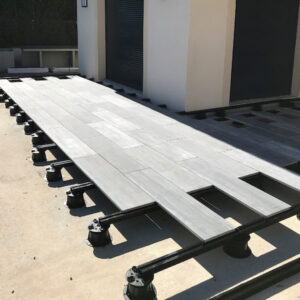 Yes, aluminum joists allow for wider spacing between pedestals, reducing the total needed. For example, with 12×48″ porcelain planks, pedestals are placed every 32″ along the joist base, rather than every 12″ under each corner.
Yes, aluminum joists allow for wider spacing between pedestals, reducing the total needed. For example, with 12×48″ porcelain planks, pedestals are placed every 32″ along the joist base, rather than every 12″ under each corner.
- Learn more about U-BRS aluminum joists or the E-BRS Easy Rail System.
- Read this ASK Buzon in the original newsletter issue.
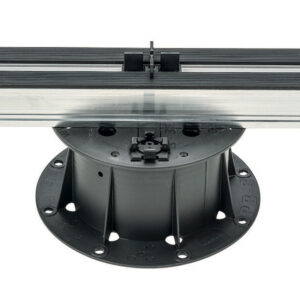 The term 70° shore refers to the hardness rating of the EPDM (Ethylene Propylene Diene Monomer) material, measured on the Shore A hardness scale. A 70° shore rating indicates that the EPDM material is moderately firm, providing a balance of flexibility and resistance to compression or deformation. This makes it ideal for use between aluminum joists, where it acts as a cushioning or protective layer, preventing damage, reducing squeaking, and maintaining stability and load-bearing performance.
The term 70° shore refers to the hardness rating of the EPDM (Ethylene Propylene Diene Monomer) material, measured on the Shore A hardness scale. A 70° shore rating indicates that the EPDM material is moderately firm, providing a balance of flexibility and resistance to compression or deformation. This makes it ideal for use between aluminum joists, where it acts as a cushioning or protective layer, preventing damage, reducing squeaking, and maintaining stability and load-bearing performance.
- Learn more about the Buzon E-BRS Easy Rail System.
- Read this ASK Buzon in the original newsletter issue.
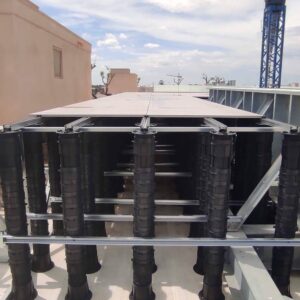 Cross-bracing is typically considered when pedestal heights reach 24 to 30 inches. At this range, installers often use aluminum C-channel bracing, screw-attached just below the pedestal heads, to add lateral support.
Cross-bracing is typically considered when pedestal heights reach 24 to 30 inches. At this range, installers often use aluminum C-channel bracing, screw-attached just below the pedestal heads, to add lateral support.
For installations up to 60 inches tall, systems are often framed using U-JOISTS and HDG Grating Panels, which lock pedestals together for added strength. This method has been used successfully in elevated pool decks and other demanding applications.
- Read this ASK Buzon in the original newsletter issue.
